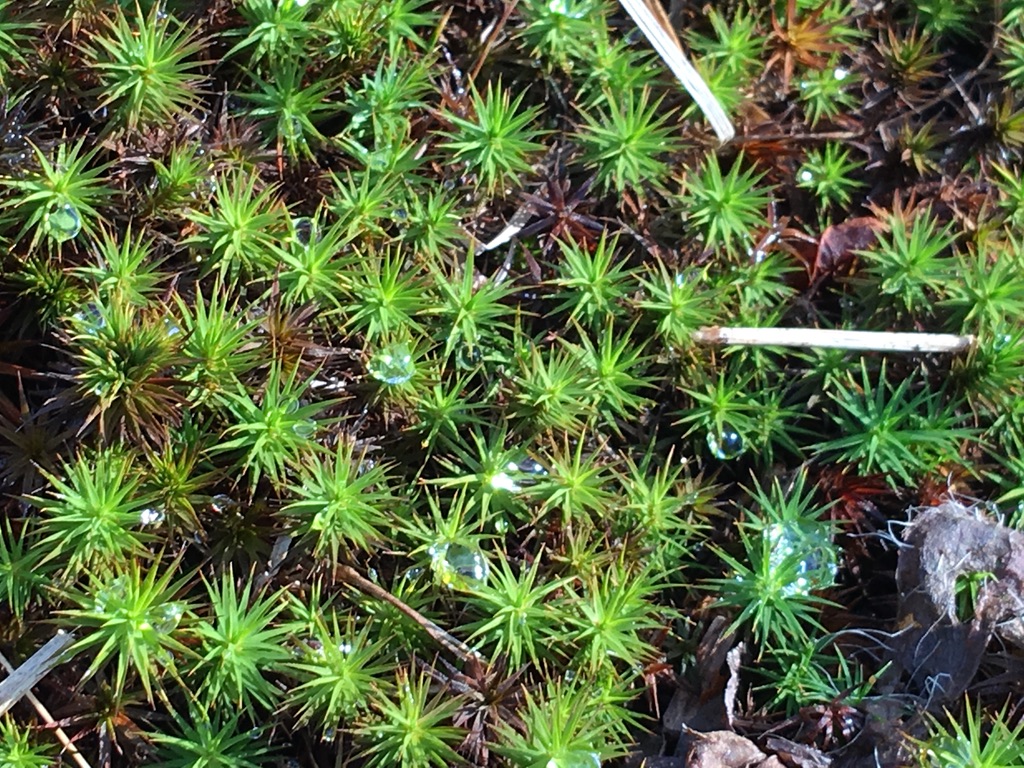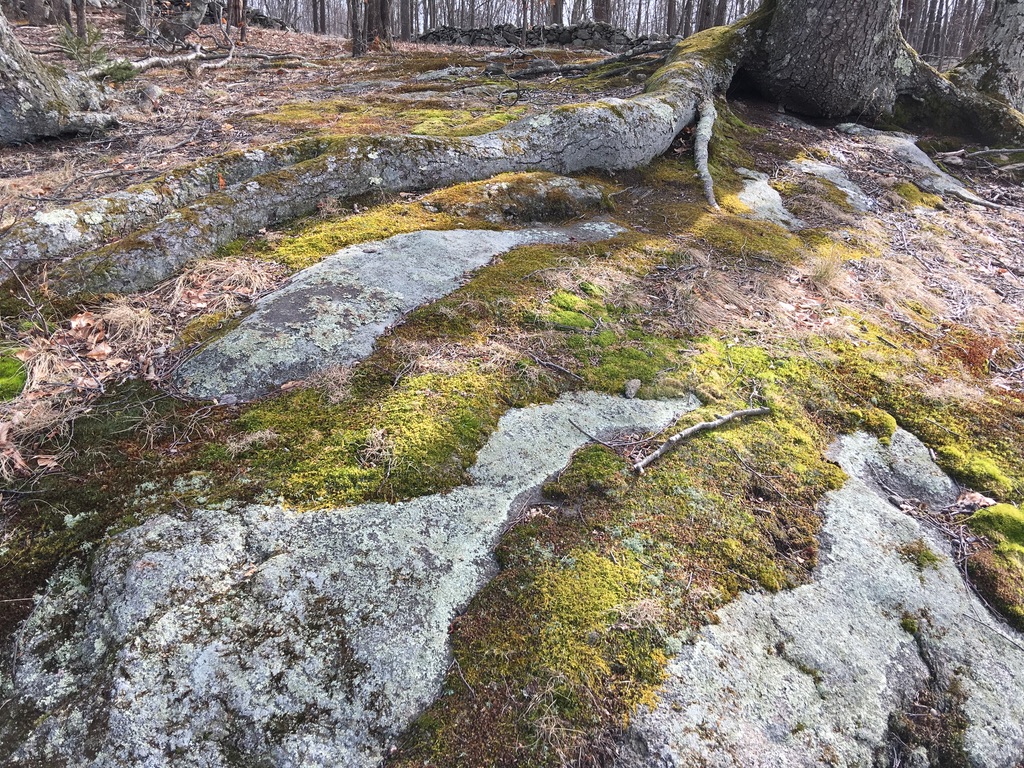
There is nothing like a wild, fantastical walk in a forest to relieve holiday stress associated with preparations for celebration–especially the painstaking wrapping and then impetuous unwrapping of gifts. We, a group of young children, young adults, parents, grandparents, and a dog, set forth twice–on Christmas Eve day and then again on cold, blustery Christmas Day–upon the forested trails of Weir Farm National Historic Site in Wilton, CT, which is run by U.S. National Park Service. As it turned out, we encountered signs of another companion, old Mr. Grizzlebeard.

On the first day the only child with us was four-year-old James, who is going through an intense rock-mineral-crystal-coin-and-treasure phase. This area of Connecticut has lots of gorgeous mica-and-quartz-infused rocks and boulders, which look like treasure. As we walked from the parking lot to the paths past the red farmhouse buildings of the farm James walked bent double with nose practically touching the ground looking for sparkling rocks. I, bent double looking at mosses and lichens, cannot relate the exact moment when James’ young uncle Douglas started referencing Mr. Grizzlebeard, the old giant who owned or owns the woods and has always treasured the vernal pools and swampy areas in his domain, but his name and influence were soon writ large in our walk.

His existence seemed quite reasonable to James for the hand of a giant was everywhere–upturned trees with their root balls horizontal in the air, great slabs of rock dripping with rock tripe lichens, and cushions and flowing carpets of moss, streaming puddles of emerald green. James quickly took an interest in the moss, even being able to identify “star moss” at a new turn in the trail.

The lawyer in our group was taken by the striped bracket fungi that ornamented a fallen tree trunk.

James soberly examined the scenes before him representing evidence of the giant’s rampageous nature, of which he did not disapprove. Tall gnarly thickets of mountain laurel dominate the understory, and the highly reflective nature of their leaves dazzled the eyes with fantastical shine.

Christmas Day hit early, well before 7:00 am, but we, the wrapping-weary adults, and the father so sore from hernia surgery, mustered fortitude to be there–or be square in the words of good friends– for the excited young ones to proceed with unwrapping. Then before noon, after a few eggs, bread, and some fruit, we headed back to Mr. Grizzlebeard’s kingdom. We were drawn–some say that to set a new habit you only need day 1, and then day 2 follows of its own accord; we needed the return trip. We needed to unwrap ourselves, and where better than with rocks, moss, lichens, and trees.

On this second day we had almost the entire group, which now included three young children, 9, 6, and 4. As I was bringing up the rear, again, I overheard a conversation between the two brothers, one almost 7 and James (still a solid 4). Luke, the older brother ever looking for justice and fair play, said to James, “If we agree to share all our toys, you would have twice as many toys.” They were walking shoulder to shoulder companionably. James looked troubled. Perhaps he remembered his transgression of Christmas Eve when before he brushed his teeth he had gone into Luke’s room to remove something of Luke’s for a bit. Probably he enjoyed that experience even if he regretted the nature of transgression. All things considered, however, Luke’s proposition was a no-go for James. Luke handled the decision well, the outcome of long practice in seeing his dreams of a just harmony (hard to find for a middle child) deferred. “Ok,” he said. They walked on into the glistening forest.

A walk is an occasion for paying attention to Earth’s kingdoms, and for coming to terms with how we evaluate, measure, and understand our own kingdoms. And a time to imagine giants. In E. M. Forster’s futuristic tale ‘The Machine Stops” people do not look at the real world of nature anymore because all their needs are answered by technology. A mother reluctantly leaves her cocoon-like room maintained by the Machine to take a trip on an “air-ship” to see her son who has rebelled and is near death.
At midday she took a second glance at the earth. The air- ship was crossing another range of mountains, but she could see little, owing to clouds. Masses of black rock hovered below her, and merged indistinctly into grey. Their shapes were fantastic; one of them resembled a prostrate man.
“No ideas here,” murmured Vashti, and hid the Caucasus behind a metal blind.
In the evening she looked again. They were crossing a golden sea, in which lay many small islands and one peninsula. She repeated, “No ideas here,” and hid Greece behind a metal blind.
She is of course wrong. The literal shapes and forms of natural landscapes do inspire ideas–and stories about giants.


Weir Farm is described as “the only national park devoted to art” and “a national legacy to American Impressionism, the creative spirit, and historic preservation.” It was the home of Julian Alden Weir (1852-1919), a founding practitioner and proponent of American Impressionism. Although initially horrified by European impressionists like Monet and Renoir whose work he encountered in art studies in Paris as a young man, the landscape of Weir Farm profoundly influenced his eye and subsequent style.

He acquired the 153-acre farm through a trade with a wealthy art collector who wanted a painting Weir had purchased in Europe. An additional ten dollars sealed the deal. In the summer one can wander around the property with art supplies in a satchel provided by the park.

Weir most often painted the open fields of his farm, but there is one he made of bouldery rocks that captures the mystery of Grizzlebeard’s kingdom.

Weir was self-deprecating about his work as a painter. He wrote , “Really, I know not what I am best at. I believe I am a fisherman, a dreamer and lover of nature…and if I lived to 120 I might become an artist.” He explained his aspiration as an artist this way: “… he who renders nature to make one feel the sentiment of such, to me is the greatest man.”

Rocks, moss, lichens, and trees: Grizzlebeard was quite an artist as well.